

Demystifying Machine Intelligence. Can an Algorithm Write a Better News Story Than a Human Reporter? Had Narrative Science — a company that trains computers to write news stories—created this piece, it probably would not mention that the company’s Chicago headquarters lie only a long baseball toss from the Tribune newspaper building.

Nor would it dwell on the fact that this potentially job-killing technology was incubated in part at Northwestern’s Medill School of Journalism, Media, Integrated Marketing Communications. Those ironies are obvious to a human. But not to a computer. At least not yet. For now consider this: Every 30 seconds or so, the algorithmic bull pen of Narrative Science, a 30-person company occupying a large room on the fringes of the Chicago Loop, extrudes a story whose very byline is a question of philosophical inquiry. And the articles don’t read like robots wrote them: Friona fell 10-8 to Boys Ranch in five innings on Monday at Friona despite racking up seven hits and eight runs.
OK, it’s not Roger Angell. Hammond assures me I have nothing to worry about. Will Robots Replace Our Pastors? (I usually write about God’s hospitality over at my main blog, A Friendly Emptiness, but this topic grabbed my attention and lured me back to this–otherwise unused–blog.

Enjoy! –Wayne) I, like most bloggers, usually focus my posts on the issues everybody’s talking about. Today, though, I’d like to address an issue nobody is talking about—yet. According to Kevin Kelly’s article in December’s issue of Wired magazine, “Better Than Human: Why Robots Will — And Must — Take Our Jobs”, by the end of this century, 70% of today’s workers will be replaced by robots. “The rote tasks of any information-intensive job can be automated. My first reaction to these claims was—and I’m sure yours is too—that my job was a clear exception to this prediction.
Could pastors like me be replaced by robots? Let’s break this down by the different tasks and roles pastors fill. Preaching An obvious place to start is preaching. Counseling/Pastoral Care Let me introduce you to MindMentor, the automated therapist. Why superintelligence can be dangerous (Opinion) Machines have surpassed humans in physical strength, speed and stamina.

What if they surpassed human intellect as well? Science fiction movies have explored this question. In the classic "2001: A Space Odyssey," astronaut David Bowman, played by Keir Dullea, struggles for control of the spacecraft against the sentient computer HAL 9000. In "The Matrix," Keanu Reeves stars as Neo, who must find a way to win the war against the Matrix, intelligent machines that have taken over the world. Human-friendly robots C-3P0, left, and R2-D2 in the "Star Wars" series. Arnold Schwarzenegger plays a cyborg assassin in "The Terminator. " Good robots known as the Autobots and bad robots, the Decepticons, fight for dominance on Earth in the "Transformers" franchise.
Cuadrupeds. Believable Agents and Intelligent Story Adaptation for Interactive Storytelling. Interactive Narrative is an approach to interactive entertainment that enables the player to make decisions that directly affect the direction and/or outcome of the narrative experience being delivered by the computer system.

Interactive narrative requires two seemingly conflicting requirements: coherent narrative and user agency. We present an interactive narrative system that uses a combination of narrative control and autonomous believable character agents to augment a story world simulation in which the user has a high degree of agency with narrative plot control. A drama manager called the Automated Story Director gives plot-based guidance to believable agents.
The believable agents are endowed with the autonomy necessary to carry out directives in the most believable fashion possible. Agents also handle interaction with the user. Computing Machinery and Intelligence A.M. Turing. Merging the biological, electronic. Harvard scientists have created a type of “cyborg” tissue for the first time by embedding a three-dimensional network of functional, biocompatible, nanoscale wires into engineered human tissues.

As described in a paper published Aug. 26 in the journal Nature Materials, a research team led by Charles M. Lieber, the Mark Hyman Jr. Professor of Chemistry at Harvard, and Daniel Kohane, a Harvard Medical School professor in the Department of Anesthesia at Children’s Hospital Boston, developed a system for creating nanoscale “scaffolds” that can be seeded with cells that grow into tissue. “The current methods we have for monitoring or interacting with living systems are limited,” said Lieber. “We can use electrodes to measure activity in cells or tissue, but that damages them. Contributing to the work were Robert Langer, from the Koch Institute at the Massachusetts Institute of Technology, and Zhigang Suo, the Allen E. and Marilyn M.